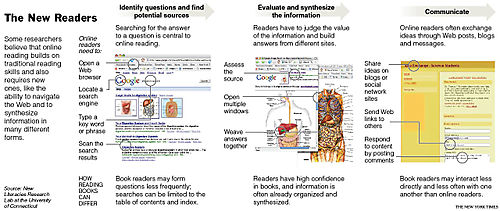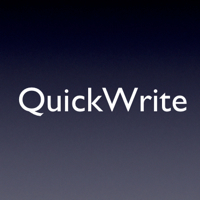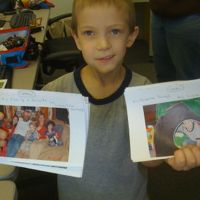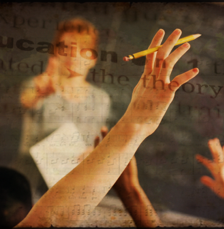As teenagers’ scores on standardized reading tests have declined or stagnated, some argue that the hours spent prowling the Internet are the enemy of reading — diminishing literacy, wrecking attention spans and destroying a precious common culture that exists only through the reading of books. … But others say the Internet has created a new kind of reading, one that schools and society should not discount. The Web inspires teenagers who might otherwise spend most of their leisure time watching television, to read and write. …Clearly, reading in print and on the Internet are different. On paper, text has a predetermined beginning, middle and end, where readers focus for a sustained period on one author’s vision. On the Internet, readers skate through cyberspace at will and, in effect, compose their own beginnings, middles and ends. More Literacy_Debate_Online,_RU_Really Reading? 120KB pdf
Bloom’s Taxonomy: Creativity and 21st Century Literacy
Students Can Become Proficient Writers – Try a QuickWrite
The recently released NAEP report suggests that only about one-third of our eighth graders and about one-quarter of the nation’s high school seniors are proficient writers. The results are not much better than the results of the NAEP’s last report in 2002. More
If we want to bring these numbers up, students should be writing on a daily basis in all of their classes. So how do we give students more opportunities to hone their writing skills without overburdening our secondary teachers with loads of papers to grade?
Why not use the QuickWrite strategy.
- As students enter class, they see a prompt on the front board that requires them to revisit a previously lesson. This makes more productive use of the opening minutes of class where teachers are usually tied up in “housekeeping” tasks.
- Students are trained to write briefly, but in complete sentences.
- After five minutes, selected students read their answers aloud to the class. Students are instructed to read exactly what they have written. This requires quick organization of thoughts and prevents rambling oral replies.
The QuickWrite is followed by short discussion. Teachers call on volunteers, drawing out divergent viewpoint:
- “Does anyone have a different idea?”
- “How did those two students’ QuickWrites differ?”
- “What do these QuickWrites tell us we should study today?”
This strategy stimulates students’ higher-order thinking about a concept from the previous day. Teachers can easily check for understanding before beginning a new lesson. The class is now ready to link this newly anchored understanding to the content of the upcoming class.
Most importantly, a QuickWrite gives students a chance to evaluate what they think is significant and share what they’ve learned with their peers. It restructures the typical teacher-led discussion that too often finds the teacher playing “guess what I’m thinking?”
For more ideas and resources, visit my literacy posts on this blog.
Reluctant Reader as Author
Literacy specialist, Pat Martin, authored this guest blog on one of publishing projects.
Pat Martin last guest blogged about the Parents’ Literacy Publishing Project
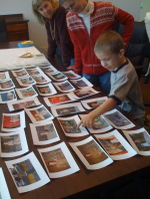 Cuyler, a winsome first grader, has published his first book. The experience encouraged him to exclaim, “I’m going to publish more than 1000 books. I have so much more to say.”
Cuyler, a winsome first grader, has published his first book. The experience encouraged him to exclaim, “I’m going to publish more than 1000 books. I have so much more to say.”
Mid-way through his second year of formal schooling, Cuyler should be reading about level 9/10 (guided reading text level as described by Pinnell and Fountas). He’s not. However, after reading a text created by MaryAnn McAlpin, a retired Reading Recovery teacher, for her grandson, Cuyler was motivated to create his own text using that model.
“I’m going to publish more than 1000 books. I have so much more to say.” ~ Cuyler, a 1st grader
Writing his personal text benefits Cuyler in so many ways. His extensive daily vocabulary is supported by actual printed text. His interests, vehicles of every description and outdoor life, become the basis of his text which further stimulates his daily effort to acquire reading skill. As such noted advocates for boy literacy as Ralph Fletcher and Michael Gurian note, primary texts and writing prompts seldom deal with the world that interests boys. There is scant opportunity to connect with the texts, to bring personal experience into the reading/writing or to interact with the text content.
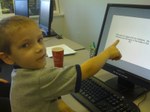 Capturing Cuyler’s explanations and descriptions as a book’s text mimics interactive writing or the daily journal writing in the reading Recovery lesson. And what child wouldn’t read and reread a book of their pictures and writing? What better way to achieve fluency? Certainly a more exciting, engaging and authentic method than grappling through Cuyler’s four inch thick stack of Dolch sight words – a practice he he finds less than engaging. Cuyler now sees himself as a literate individual. He is excited about the growing up as a reader and writer rather than defeated by the challenges that text holds.
Capturing Cuyler’s explanations and descriptions as a book’s text mimics interactive writing or the daily journal writing in the reading Recovery lesson. And what child wouldn’t read and reread a book of their pictures and writing? What better way to achieve fluency? Certainly a more exciting, engaging and authentic method than grappling through Cuyler’s four inch thick stack of Dolch sight words – a practice he he finds less than engaging. Cuyler now sees himself as a literate individual. He is excited about the growing up as a reader and writer rather than defeated by the challenges that text holds.
By providing text that supports him as a reader and validates him as a writer, Cuyler is on the path of literacy. And he is an excited traveler who wants to know “how many days until we go back to that learning lab so I can publish books.”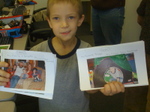
For sometime now I’ve been an advocate of new print on demand technologies to give students a chance to publish their learning for an authentic audience and purpose. I’ve partnered with Pat Martin, a literacy specialist and Suzanne Suor, an educational technology consultant, to open a Educational Publishing Learning Lab in Rochester NY. We offer a variety of training packages to assist teachers and districts in taking advantage of the new opportunities in digital publishing. The lab is located at ColorCentric digital publishers, so participants can not only learn how to publish, but tour the facility to see books being made. For more information on how you and your students can publish your own books visit our website Read > Think > Write > Publish
A Comprehensive Approach to Rigor, Relevance and Literacy
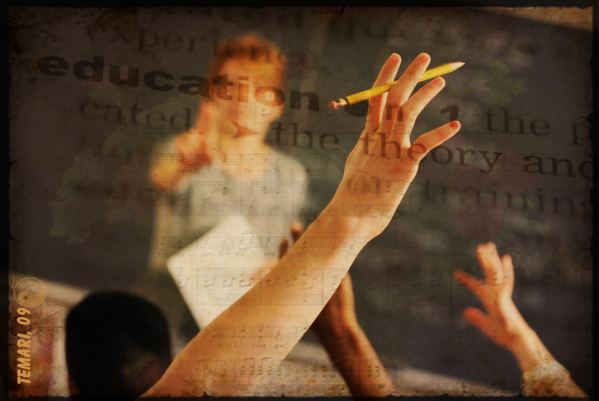
Learning time
2007 wraps up with a week long series of workshops at Lakeland High School in White Lake, Michigan. On Monday, I’ll do an opening session on rigor, relevance and literacy strategies in the content area for the entire high school faculty. But it doesn’t stop there.
On Tuesday, I’ll guide a group of about 15 teachers in classroom walk–through training. They will form a peer support group to assist teachers in reflecting on their instructional practice. Wednesday, I work with the Lakeland ninth grade team designing interdisciplinary approaches to integrating the themes across the curriculum. On Thursday and Friday, I work with selected departments to assist them in developing lessons in their disciplines. In addition, I’ll be giving an evening presentation for parents, school board and community. They need to have an understanding of new perspectives in teaching and learning.
I have to congratulate school principal, Bob Behnke, on his comprehensive approach to supporting his teachers. He’s leveraging one professional development day and a rotating pool of subs to give his faculty a variety of settings to reflect on instructional practice and develop new approaches.
The week proved to be a very rewarding opportunity for me to work with a creative group of teachers in workshops and walk-through sessions. Here’s some of the follow up emails I’ve received from teachers at Lakeland –
Peter,
It was a pleasure to meet with you today. Thank you for conducting the inservice in a way that was engaging. It was a special treat to attend an inservice for something that will definitely benefit me, my students, and our school community. Too often we are asked to attend workshops that have great ideas and, I’m sure, the best intentions, but they fall short. I really appreciated having the opportunity to discuss freely the state of education, identify areas where we can apply rigor and relevance in our classrooms, and time to work with my peers. Walking out of the inservice with materials, resources and ideas I can implement tomorrow is icing on the cake.
Thank you!
Brigid————-
Peter,
I wanted to thank you again for the work you did this past week at Lakeland. I know that the vast majority of the faculty found your information useful and several informed me that they had already incorporated some of the rigor and relevancy into their lesson plans. This shows me their willingness to realize that they can improve the way they teach to really reach students at a higher level. This would not have happened if you had not put a mirror to their faces and let them know that they are good teachers who could be doing more.
Sincerely,
Marc—————
Peter –
I just wanted to thank you for spending a week in our building, and in particular for the work you did with us on Wednesday regarding the 9th grade teams. So often our professional development is mostly talk with very little time for application, but I truly appreciated the resources, ideas, and opportunity for professional discussion that your session provided for us. I particularly loved the digital book idea. In fact, I’m planning to implement it right away in my current unit.
Thanks again, and take care,
Maggie
Image credit: flickr/Temari 09
